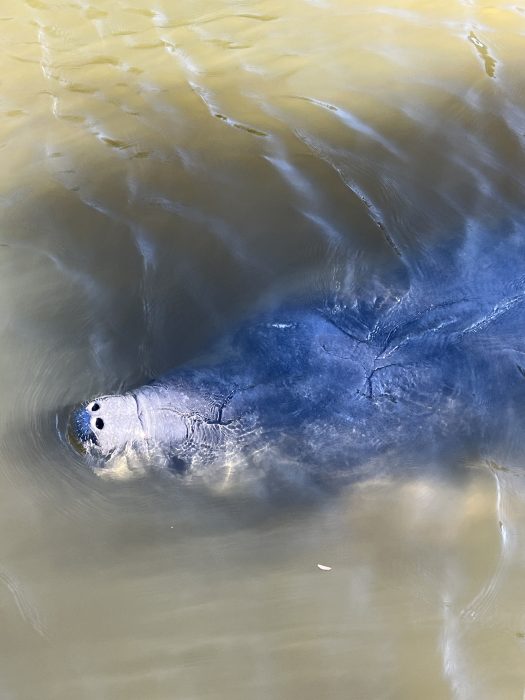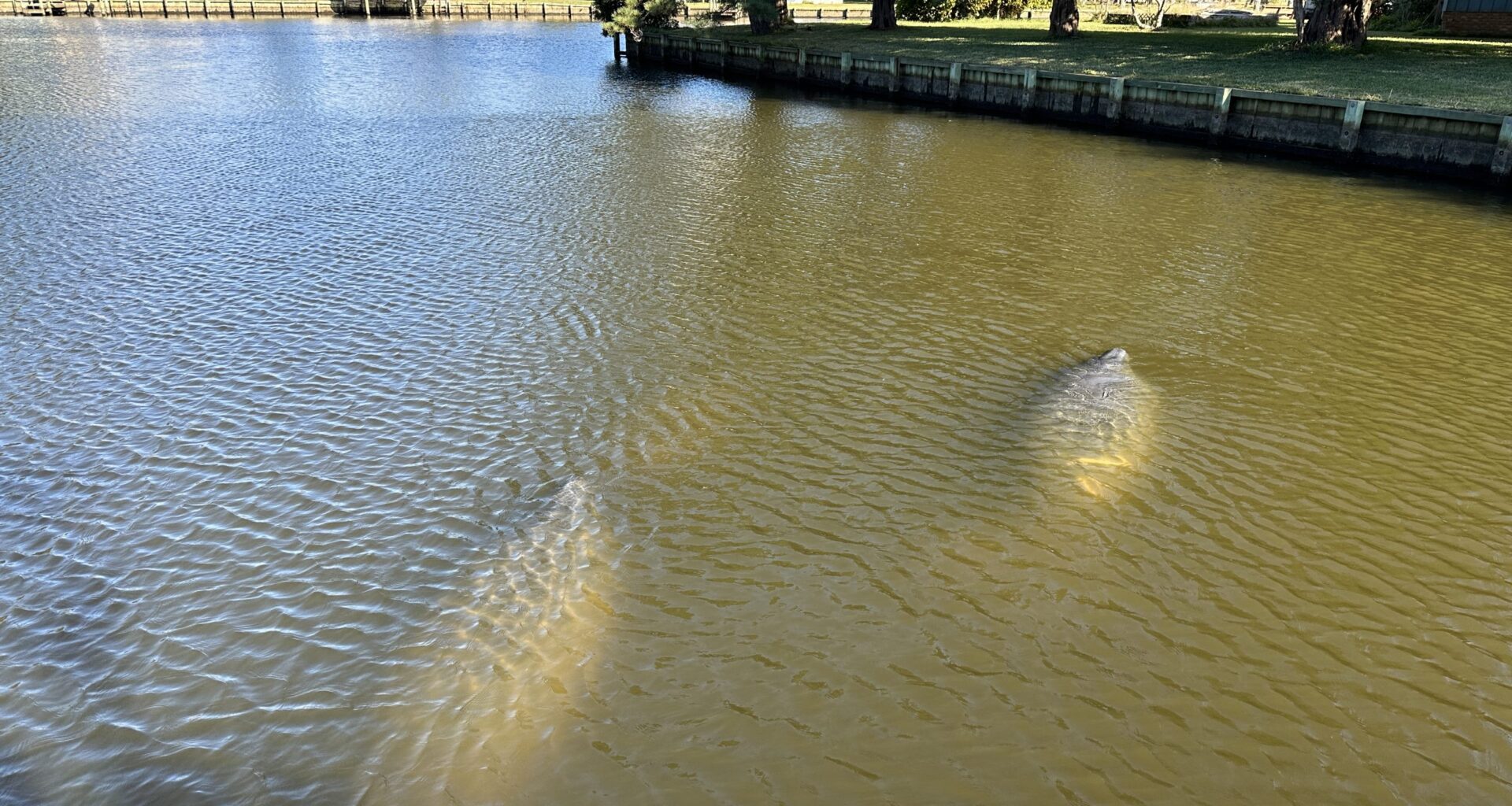By Jenette’s Pier staff
Now that summer is in full swing, Florida manatees will be visiting the waters surrounding our barrier islands collectively known as the Outer Banks.
According to Marina Doshkov, the marine mammal stranding coordinator for Jennette’s Pier, which is owned and operated by the North Carolina Aquariums under the Department of Natural and Cultural Resources, there are a number of things people can do to keep these out-of-town guests safe during their visits.
“First off, practice passive observation,” she said. “Observe from a distance and from above the water — avoid touching, feeding or giving water to manatees.”
It’s also important to be mindful of noise and splashing. Manatees may be resting, and loud noises could startle them, Doshkov added.
“And please don’t block their paths,” she added. “Avoid chasing or blocking manatees as they travel.”
Wearing polarized sunglasses makes it easier to spot manatees. In addition, look for “footprints” on the water’s surface made by manatee tails or their nostrils as they surface.
“Boaters need to slow down, especially in marinas,” she said. “Reducing speed gives you a greater chance to avoid manatees and for them to avoid your vessel.”
Manatees are protected by the Marine Mammal Act of 1973 and Florida Manatee Sanctuary Act of 1978. It is illegal to feed, harass, harm, pursue, hunt, shoot, wound, kill, annoy or molest manatees.
To help with tracking manatee visits, Doshkov asks everyone to report any sightings to the Outer Banks Marine Mammal Network at 252-455-9654.
“We’re just trying to get a record of where people are seeing manatees,” she noted. “And that helps us identify spots where they’re hanging out.
Speaking of hanging out, these animals’ visits often linger into the fall and winter months, especially if people feed them or give them fresh water.
 Manatee nose out of water.
Manatee nose out of water.
This type of positive reinforcement sends the wrong message to the animals, and they are more likely to stick around even when the temperatures get colder, Doshkov said.
“It’s like saying, ‘hey come over here and hang out with me,’” she said. “That just encourages the animal to stick around longer when they should be migrating south, and so it puts them at risk of cold stress.
“We want them to be moving on, not hanging out getting food from a local source,” Doshkov added.
Last fall, Aquariums staff assisted Florida Fish and Wildlife officers in relocating a manatee that did linger in Dare County and eventually meandered over to Greenville, which is a couple hours west.
On the oceanside, Jennette’s Pier Director Mike Remige reports that at least one manatee has been seen swimming by each year since 2011. People get excited when they see these curious gentle giants who grow to nine feet long and weigh between 880 to 1,200 pounds.
“It’s their general nature –they appear to be soft and cuddly,” he said. “We tend to anthropomorphize them (give them human traits), and think they’re big teddy bears, big, big water bears,” he said.
Because more people live along the Outer Banks than ever, Remige said there is an increased number of sightings being reported.
“I know we’re seeing more manatees than ever before,” he added. “Whether that’s just because people are doing a better job of reporting them or because there are more of them in the water, is hard to determine.
“But I believe other parts of the East Coast are also seeing an increase in the number of manatees moving north every summer,” Remige added.
He knows of one manatee that’s been seen in Nags Head and in Chesapeake Bay.
“He’s been identified here as well as seen and identified in the bay over the years,” Remige added.
Scientists used healed injuries such as prop cut marks to identify the different animals.
According to Vicky Thayer, Ph.D., the North Carolina Marine Mammal Stranding Coordinator for the Aquariums, scientists from UNC-Wilmington continue to see an increase in manatees visiting North Carolina and Virginia.
About Jennette’s Pier in Nags Head. The pier is located on the oceanfront at 7223 S. Virginia Dare Trail, The Beach Road, MP 16.5, Nags Head Known as “the place to be” in Nags Head during the summer season, Jennette’s Pier offers anglers a wide variety of fish to target year-round while sightseers can watch brown pelicans overhead and bottlenose dolphins swimming in the sea. The Pier is under the North Carolina Department of Natural and Cultural Resources and is accredited by the Association of Zoos and Aquariums. For more information, please visit www.jennettespier.net or call (252) 255-1501.
About the North Carolina Department of Natural and Cultural Resources
The N.C. Department of Natural and Cultural Resources (DNCR) manages, promotes, and enhances the things that people love about North Carolina – its diverse arts and culture, rich history, and spectacular natural areas. Through its programs, the department enhances education, stimulates economic development, improves public health, expands accessibility, and strengthens community resiliency. The department manages over 100 locations across the state, including 27 historic sites, seven history museums, two art museums, five science museums, four aquariums, 35 state parks, four recreation areas, dozens of state trails and natural areas, the N.C. Zoo, the N.C Symphony, the State Library, the State Archives, the N.C. Arts Council, the African American Heritage Commission, the American Indian Heritage Commission, the State Historic Preservation Office, the Office of State Archaeology, the Highway Historical Markers program, the N.C. Land and Water Fund, and the Natural Heritage Program. For more information, please visit www.ncdcr.gov
